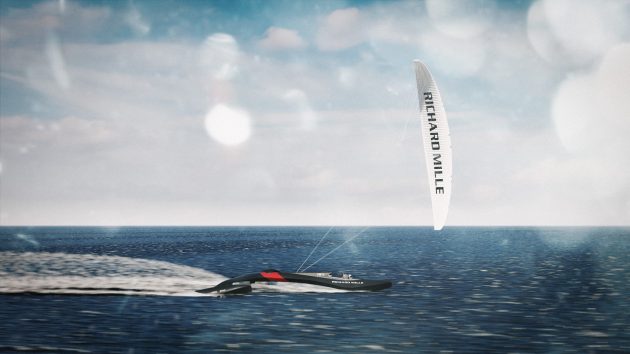SP80 has been designed to try to set a new sailing speed record and become the worlds fastest sailboat. But can the team reach their ambitious target?
SP80 was conceived by three graduates of Swiss engineering school, École Polytechnique Fédérale de Lausanne; Benoît Gaudiot, Xavier Lepercq and Mayeul van den Broek.
In terms of the teams currently looking to set a new new record (currently another team, Syroco, is also developing a boat they hope will set new records), the SP80 concept probably qualifies as a slightly more ‘normal’ concept – as much as that statement can be made when referring to one-off craft aiming to be one of the fastest sailboats in the world.
The craft will use a pair of floats located on each side of the main cockpit to produce stability and is designed to skim the surface. In this respect, the concept is not so far away from the current fastest sailboat in the world, Sailrocket 2, which also skimmed the surface.
Article continues below…
Syroco: Radical design aiming to set a new speed record
If having a top-flight speed sailor as a part of your team taking on the challenge of creating the world’s…
Fastest sailboats: The teams aiming to break 80 knots
On 24 November 2012, Paul Larsen and his Sailrocket team rewrote our understanding of the physics of sailboats, stamping their…
Also similar to the Sailrocket concept is a large foil at the aft end of the craft which will take care of the lateral forces from the kite used by the SP80 team. This foil will be what they refer to as super-ventilating – ventilation is different from cavitation as it refers to air sucked down along the length of the foil from the surface.
As the SP80 foils break the surface, they will be manipulating this ventilated air in a similar way to that which Syroco is manipulating air created by the cavitation pressure voids. Thus the team has superventilated foils rather than supercavitating.

The SP80 prototype during testing on Lake Geneva. Photo: SP80
Another superventilated foil features at the bow, which will be used as a rudder, while a further two small foils sit under each float to keep the boat skimming over the surface.
A key part of the SP80 concept, and one where both it and Syroco are similar, will be the aft kite control module. This module can rotate around the circular aft section of the hull and is attached to the main foil.
Thus as the kite increases in height, the large aft foil rotates closer to being parallel with the water’s surface and as the kite gets closer to the water, the aft foil becomes closer to vertical. Again this is a system designed to counter the forces of the kite, maintaining a flat boat while power increases.
The SP80 team has already made and tested a prototype on Lake Geneva and they also intend to be out on the water and aiming for a record run in 2022.
Follow the progress of SP80 at their website.
 If you enjoyed this….
If you enjoyed this….
Yachting World is the world’s leading magazine for bluewater cruisers and offshore sailors. Every month we have inspirational adventures and practical features to help you realise your sailing dreams.Build your knowledge with a subscription delivered to your door. See our latest offers and save at least 30% off the cover price.






